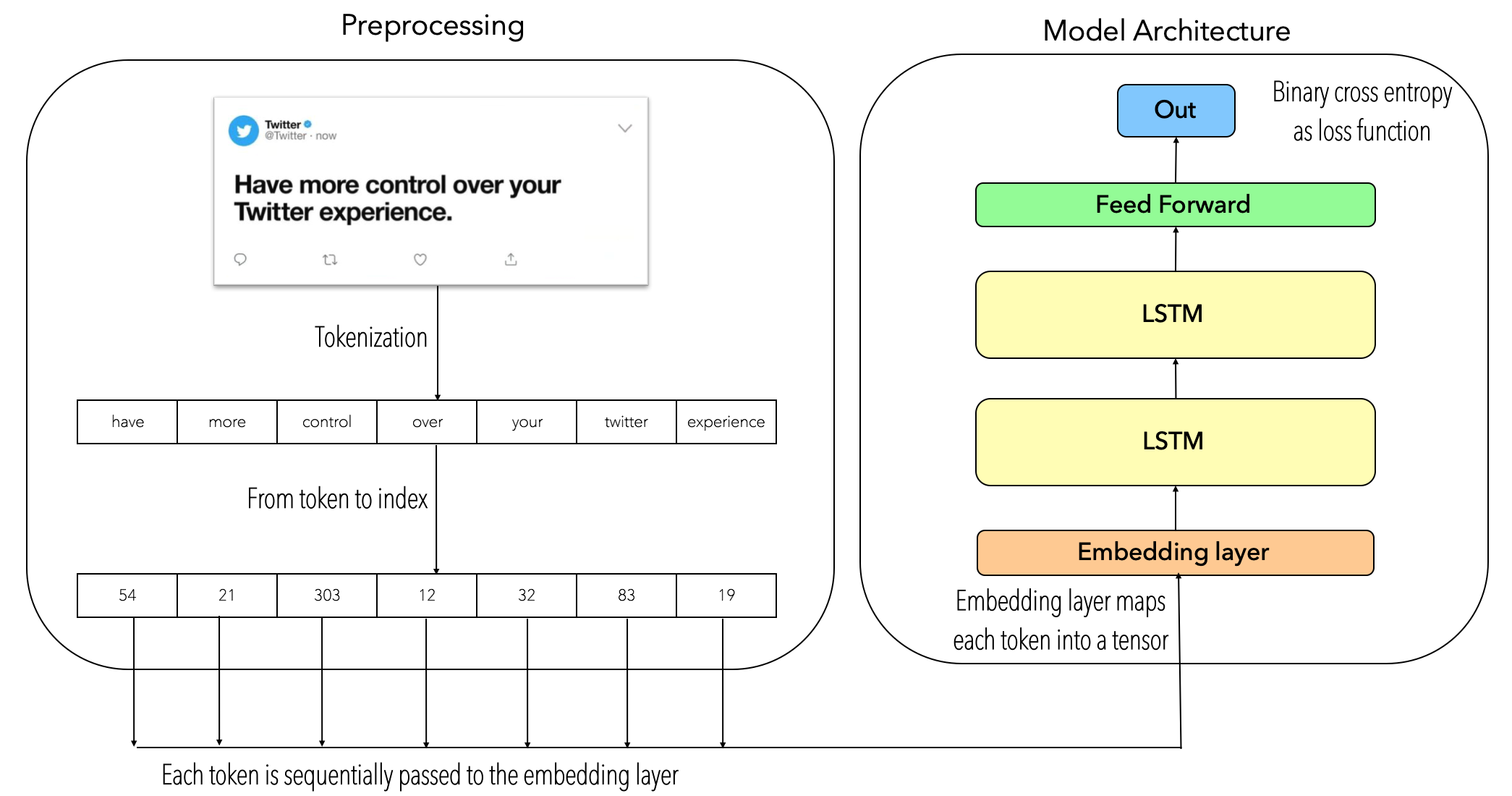The aim of this repository is to show a baseline model for text classification by implementing a LSTM-based model coded in PyTorch. In order to provide a better understanding of the model, it will be used a Tweets dataset provided by Kaggle
If you want to delve into the details regarding how the text was pre-processed, how the sequences were generated, how the neural network was built from the LSTMCells and how the model was trained, I highly recommend reading the blog: Text Classification with PyTorch
As it was mentioned above, the implemented dataset is about Tweets regarding fake news. The rawdataset contains some unnecessary columns which are going to be removed in the preprocessing step, in the end, we will be working with a dataset with a head such as this:
| id | text | target |
|---|---|---|
| 1 | Our Deeds are the Reason of this #earthquake May ALLAH Forgive us all | 1 |
| 2 | SOOOO PUMPED FOR ABLAZE ???? @southridgelife | 0 |
| 3 | INEC Office in Abia Set Ablaze - http://t.co/3ImaomknnA | 1 |
| 4 | Building the perfect tracklist to life leave the streets ablaze | 0 |
This raw dataset can be found in data/tweets.csv.
As it was already commented, the aim of this repository is to provide a base line model for text classfication. In this sense, the model is based on a two-stacked LSTM layers followed by two linear layers. The dataset is preprocessed through a tokens-based technique, then tokens are associated to an embedding layer. The following image describes the pipeline of the model.
This model was developed under these specified versions:
torch==1.0.1.post2
torchtext==0.6.0
tensorflow==1.12.0
Keras==2.0.0
numpy==1.15.4
pandas==1.0.3
The model can be executed easily by typing:
python main.py
You can define some hyperparameters manually, such as:
main.py [-h] [--epochs EPOCHS] [--learning_rate LEARNING_RATE]
[--hidden_dim HIDDEN_DIM] [--lstm_layers LSTM_LAYERS]
[--batch_size BATCH_SIZE] [--test_size TEST_SIZE]
[--max_len MAX_LEN] [--max_words MAX_WORDS]
The follwowing configuration was implemented in order to achieve the best results
python -B main.py --epochs 10 --learning_rate 0.01 --hidden_dim 128 --lstm_layers 2 --batch_size 64
by getting the following output:
Epoch: 1, loss: 0.53032, Train accuracy: 0.59376, Test accuracy: 0.63099
Epoch: 2, loss: 0.43361, Train accuracy: 0.63251, Test accuracy: 0.72948
Epoch: 3, loss: 0.36803, Train accuracy: 0.76141, Test accuracy: 0.75509
Epoch: 4, loss: 0.26117, Train accuracy: 0.80821, Test accuracy: 0.77807
Epoch: 5, loss: 0.19844, Train accuracy: 0.83547, Test accuracy: 0.77741
Epoch: 6, loss: 0.16377, Train accuracy: 0.86453, Test accuracy: 0.77216
Epoch: 7, loss: 0.02130, Train accuracy: 0.88391, Test accuracy: 0.75509
Epoch: 8, loss: 0.00315, Train accuracy: 0.89704, Test accuracy: 0.74787
Epoch: 9, loss: 0.02075, Train accuracy: 0.91018, Test accuracy: 0.76428
Epoch: 10, loss: 0.01348, Train accuracy: 0.92808, Test accuracy: 0.75378
So the learning curves will look like:
As it was mentioned, the aim of this repository is to provdie a base line for the text classification task. It's important to mention that, the problem of text classifications goes beyond than a two-stacked LSTM architecture where texts are preprocessed under tokens-based methodology. Recent works have shown impressive results by implemeting transformers based architectures (e.g. BERT). Nevertheless, by following this thread, this proposed model can be improved by removing the tokens-based methodology and implementing a word embeddings based model instead (e.g. word2vec-gensim). Likewise, bi-directional LSTMs can be applied in order to catch more context (in a forward and backward way).
The question remains open: how to learn semantics? what is semantics? would DL-based models be capable to learn semantics?

